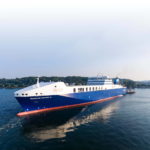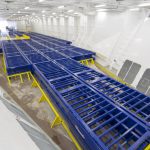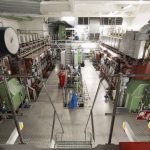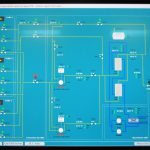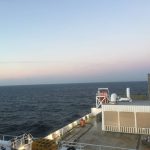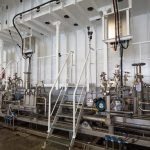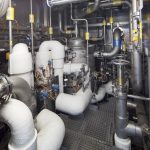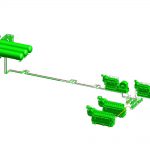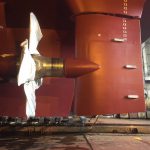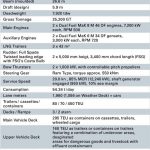FSG’s recent RoRo newbuilding »Searoad Mersey II« was applauded in the industry primarily for its innovative LNG trailer technology. For good reasons. However, other features are no less important,
writes Michael Meyer
The award »Ship of the year« was given by HANSA for the combination of the first-ever LNG system with[ds_preview] trailers as rolling tanks and a highly efficient hull design, leading to a better cargo intake at lower weight. The Flensburger Schiffbau-Gesellschaft was chosen for this year’s award because of both its in-house engineering expertise and the bravery to break new ground.
LNG has not yet seen the breakthrough as a fuel in the maritime industry it was predicted to see since several years. However, this is primarily due to the lack of sufficient bunkering infrastructure and not least due to the huge financial problems, ship owners are facing for years now, hindering them from realizing newbuilding projects with LNG. The technology itself and its use for shipping is no miracle anymore. The question is more how to specify and integrate it in specific vessel segments. Creativity is needed.
Bearing this in mind, RoRo operator SeaRoad approached FSG. And obviously theyfound a partner with whom they managed to find a taylor-made solution for their specific demand. At last, the discussions led to a solution which both parties applaud.
The eventual bunkering marks the last step in the process developed. The most important part of it are trailers carrying 43m3 tanks with LNG. Since Australia has significant LNG reserves these trailers can easily be loaded ashore at an LNG plant. Thereafter, they are transported by road and finally loaded on board the vessel. On the aft part of the upper deck, a special garage is located.
SeaRoad and FSG – a subsidiary of Norwegian Siem Group – estimate this LNG system to be a major advantage as both costs and space for fixed tanks can be saved. At the same time it provides additional flexibility in port infrastructures where no reliable LNG bunkering can be provided.
In the garage the trailers are parked, up to three of them at a time. Each of them is connected via a hose to the LNG system. As the garage is located three decks above the engine room, it is just piping going down a few meters. »The process is very simple and the connection fully automated. You cannot start or disconnect the trailer before all the safety steps are completed,« Henrique Pestana, Chief Design Officer (CDO) at FSG, tells HANSA exclusively. Virtually, the trailers are the LNG tanks for the vessel, like usual fuel tanks. »So in this case you have no LNG tanks, it is stored in the trailers, from there fed to the LNG systems and from there to the main engines and auxiliary systems to be burnt. As simple as that,« Pestana adds.
In General, SeaRoad is not the first shipowner thinking about storing LNG tanks on deck (but the only one with specific trailer system). Others have this idea, too. All of them face the problem that the tanks need space and that this space has to be deducted from the cargo space. Arabian container shipping company UASC for example expects a loss of up to 700 container slots when its youngest newbuildings, designed as »LNG ready«, will be switched to the new technology (HANSA 08/2015). However, the extent of this loss is dependent on the LNG capacity. In SeaRoad’s case, the sailing route is quite short, so the vessel does not need much capacity. The trailer system has a range of 600 nm at 20kn. »That’s why this vessel can operate with only three trailers and still has some margins on the autonomoy. On other routes you would lose much more cargo,« the FSG designer says.
While designing the whole bunkering system, FSG and SeaRoad managed to develop a smart combination of safety, operational flexibility and simplicity, leading to a system quite easy to use for crews.
The garage is a relatively normal one, from the outside you wouldn’t see a difference to common garages. But inside it has a lot of safety features, anti-explosion equipment or CCTV. »At the end of the day it is just a garage with a rolling up door with some cryogenic piping and features«, Pestana says. It is located above the uppermost deck in a protected area quite close to the cargo – leading to the fact that the trailers can only be loaded when the vessel is empty or half empty, depending on where cargo is stowed or parked respectively.
The vessel is dual fuel designed, so it can run on MGO as well, if and when the owner decides to. According to the owner, this will happen in only 1% of the time the vessel is sailing. One example for the use of diesel might be a breakdown of other systems. Another one could be maintenance voyages.
Road regulation & uncharted waters
Pestana emphasizes the good cooperation with the Australian client, who brought a clear idea. »The client always knew that he wanted LNG. Normally every innovation is driven by the shipowner. The role of the yard and designer is to be prepared and keen to foster this innovation and translate that into something in practise, in terms of what that could mean in reality and in technology and engineering. That’s where I see our role in this project.«
Although a huge part of the design was delivered by FSG and its own design department, the final version was the result of working together. »There was a starting point. They had their own idea about the layout of the vessel, but from that starting point to what we have delivered in reality is in many aspects quite different, significantly different«, the CDO adds.
Even the idea of the trailer system emerged from the exchange between both partners, he says. »It was an intensive brainstorming. There were a lot of stumbling blocks identified immediately and some at a later stage.« For »Searoad Mersey II«, the equipment designed needs to be used on board, outside on the road and on industrial installations, where the trailer is loaded – »which you are not used to when designing ships only.« According to Pestana, this caused some headaches but the problem could be solved, not least with the assistance of DNV GL, who classified the vessel. »There were actually no road traffic rules that ruled out sea traffic rules, but compliance with both regulations required doubling up of some functions like tank valve arrangements and tank level measurement,« says Linda Sigrid Hammer, Principal Engineer for LNG, Cargo Handling & Piping Systems at DNV GL.
For safety reasons, FSG needed to simulate all steps of the bunkering procedure in detail in order not to miss anything, together with designers of the system, in that case the Linde subsidiary Cryo AB (later taken over by engine manufacturer MAN). The experts were very experienced with gas and gas installations. Pestana adds: »But of course they come from a different road, they come from industrial gas installations and although the technology is the same, when you work in a different environment, you need to rethink, to test your limit and your knowledge, trying to use the existing understanding of using that fuel, but in another setup. These aspects were more complex to all stakeholders than the engineering of the system itself. »Not to blame the rules and regulation, because they are there for a purpose, but it is also with this kind of technology, that you sometimes test and need to change the rules, or you come to the conclusion that these rules are not suitable for this new technology. And of course those that go to the process are the ones that have to take the burden to get that verification.«
There was a point when the involved people, working in uncharted waters, said: ok, we cannot comply with both rules. But eventually a solution was found. FSG and SeaRoad together with the regulators came to the conclusion by doing risk analysis that there was no issue whatsoever. »We managed to build a design that was practically possible and effective both in terms of operation and in terms of safety,« Pestana says.
Hull design and German precision
The shipyard and the shipowner claim the newbuilding to be highly efficient in terms of emissions and manoeuvrability. In this respect FSG is proud of its in-house engineering department with some good experiences on steel structures. »Therefore, we have good control of the steel structure, that allows the engineering department to work with smaller margins. The result is a more efficient vessel.« The CDO says that the yard has all the relevant people sitting very close to those working on the production and the detail engineering, the development of the hull, the weight calculation and the first stages of the design. »Whereas if I was a shipyard in Far East using a ship designer of Europe, not only that exchange would be by email. We then talk about two entities that in order to manage the risk of working together, would have to increase the margins. Which we don’t. It is not rocket science, but working precisely«, Pestana thinks. The higher efficiency is a result of the hull design combined with the steel structure, light, but strong enough. Would you see a difference with a naked eye? Pestana doesn’t think so, as it is not a specific feature you can see, but several details.
»Although we have a ›flag element‹ – it is the first vessel with this kind of LNG trailer technology – I think that all in all the main element, that adds value to the client, is the efficiency of the vessel. In terms of cargo intake, fuel costs, but also in terms of the way that the owner can operate the vessel during loading times. That’s where we have gained a lot of expertise on the RoRo market.« According to Pestana, FSG managed to build a lighter vessel – with 7,980tdw and 25,500 GT – , which in turn can bring more deadweight, leading to more revenue and improving the economics of operation.
One important demand of the shipowner was to get a vessel with special manoeuvrability capabilities, which are needed in the Bass Strait. For this, extensive studies were done with fluid dynamic computation. The two Full Spade Twisted leading edge rudders eventually installed are an FSG-owned design, »Costa Bulb«, providing a significant high lift. This is quite important for manoeuvrability, especially when you want to keep position with wind etc., which is sometimes the case in these areas. »But it is not only the rudder, but also hull design, where you have concerns like the resistance and the power to sail on a steady course.« As well, the vessel has two bow thrusters at 1,000 kW each.
In terms of emission efficiency, a silicon painting was used, in order to reduce water resistance.
From the building point of view, Pestana describes the process as very smooth, even the tests of the LNG system in Odense: »I would say that the commissioning process was not more complicated than a normal ship.« The superstructure and the deck house including the interior were built in Poland, shipped by barge to Flensburg and then installed with the assistance of a floating crane – the way FSG usually acts.
MaK delivers engines
The main propulsion system consists of two dual fuel MaK 8M46DF main engines, each with a power output of 7,200 kW. They operate via two single input/single output reduction gearboxes of Siemens on to two controllable Schottel pitch propellers. For the generation of electrical power two shaft generators of 1,500 kVA are installed. The ship is equipped with two twist flow rudders, designed by FSG, which reduce the drag during normal sailing and offer best manoeuvring performance. The vessel requires very good manoeuvring characteristics in port due to restriction on the Tasmanian side and therefore is equipped with two 1,000 kW electrically driven bow thrusters. Due to high cooling requirements of reefer trailers in port, SeaRoad required a large auxiliary capacity in addition to the shaft generators. This is provided by two dual fuel MaK 6M34DF generator sets, each with a power output of 3,100 kVA. As primary fuel the main engines as well as the auxiliary generator sets are driven with liquefied natural gas (LNG) and therefore fulfill the strict emissions standards according to IMO III rules.
According to FSG, the LNG system is designed to supply the two dual fuel main engines and two auxiliary engines in parallel to create a permanent fuel solution on sea and in harbour. During operation the LNG will be transferred from the trailers to a vaporizer unit by LNG pumps. After vaporization the natural gas will be led to the engines via the engine’s gas valve units which reduce the natural gas to the correct engine inlet pressure. The ship’s automation, engine control system, gas control system as well as the gas safety system are continuously communicating and interacting to ensure a safe ship operation.
Good feedback and interest
»Searoad Mersey II«, 181.52m long, 26.6m wide and with a draft of 6.3m, has three cargo decks. The owner wanted to be able to carry a wide variety of cargoes, be it trailers, cars and containers (on cassettes) on the Main Vehicle Deck and the car deck or in combination with designated areas for dangerous goods and even livestock on the Upper Vehicle Deck. In addition, the ship is fitted with 150 power outlets for refrigerated units.
So far, the feedback from the Australians is very good. What remains to be proven is the functionality in practise, especially of the LNG system. In the past, there have been several innovative projects causing some headache for the shipowner because of technical problems after delivery. Pestana knows that, too, but is optimistic for the FSG design.
Currently, SeaRoad is still running the ferry on MGO. But only because the company is still waiting for the remaining LNG trailers to be delivered from the Italian manufacturer. Nonetheless, the system was tested successfully before delivery, without problems, as Pestana emphasizes.
He is happy to tell that, although the vessel was specifically designed for this particular client and trade, other players in the ferry and RoRo industry are very curious about the bunkering system. LNG is one of the major trends for him. For the recently signed order from Brittany Ferries, a similar but slightly different system will be used. »This kind of equipment is very interesting especially as the infrastructure for LNG is not yet there, so the operators will need to see flexibility and redundancy in order to have a constant supply of LNG. That is why the trailer solution has attracted so much attention in the industry.« So we might see more vessels with this system? »I wouldn’t be surprised at all.«
Michael Meyer





